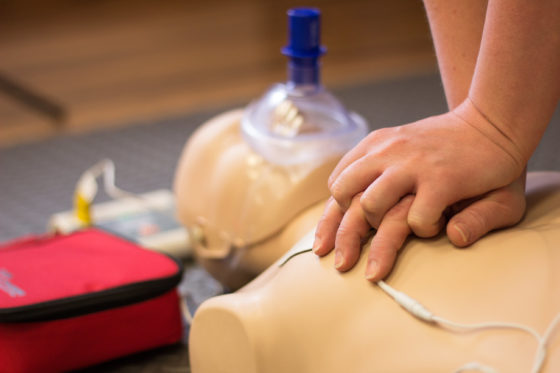Students practising CPR on manikins can get instant feedback from a wristband that indicates if they are doing chest compressions properly.

Photo credit: iStock.com/DarrenTownsend
Cardiopulmonary resuscitation (CPR) has saved the lives of many people in cardiac arrest. Now, a new tool makes it easier for people learning CPR to know if they are doing it correctly.
Traditionally, students practise CPR on manikins and rely on feedback from instructors who watch to see if they’re pushing hard enough and at the right rate. A recent research study explored whether wearable technology could help students get this feedback instead.
The study, An Assessment of Wearable Feedback Devices for CPR Training, was funded by an Innovation at Work research grant from WorkSafeBC. It had students wear wristbands that measured their chest compressions using an accelerometer synced with their tablet or cell phone.
“These devices can actually tell people in real time whether they’re doing CPR correctly. They measure exactly how far and how often they’re compressing,” says lead researcher and first aid trainer Keith Tyler. “If students know they are doing it correctly, they will be more inclined to do it in a real situation when they need to.”
Increasing confidence to do CPR
Keith, who has been a first aid trainer for 20 years, partnered on this project with St. John Ambulance. He says numerous studies show that people can often be hesitant to do CPR. Even when trained, people can be reluctant to perform CPR — largely due to a fear of doing something wrong. That’s where devices like the wristbands can be beneficial.
Says Keith: “If people have proof that they’re doing it right, it takes off the table one of the reasons why they don’t intervene.”
The pilot study did uncover one downside to using the wristbands in a classroom setting: it can be challenging for an instructor to monitor every student’s device at the same time. Keith and his fellow researchers have been talking with the device manufacturer about creating an on-screen dashboard for instructors to see everyone’s feedback at once.
“Integrating technology into teaching first aid — whether it is CPR, bandaging, or something else — is definitely the way of the future,” Keith says. “It provides more realistic training and experiential learning for people so they can actually feel confident in what they’re doing. There are going to be a lot of opportunities; CPR is just the first of many.”



This idea sounds very beneficial to CPR training and I am very interested in hearing the outcome of this study.